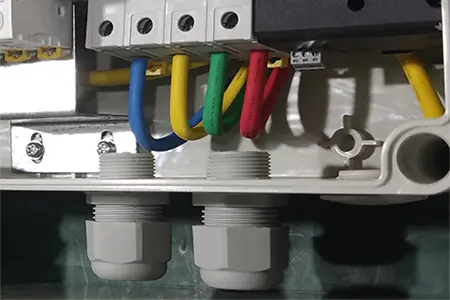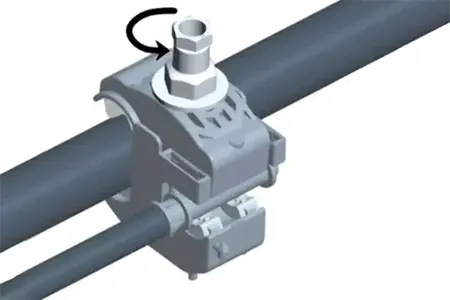How to Differentiating Surge Protector and Circuit Breaker: Learn in 3 Minutes
In this blog, we will learn about Surge Protectors vs. Circuit Breakers, and by the end of this blog, you will understand the differences between their applications, functions, and types.Surge Protection Devices (SPDs) are electrical devices that are commonly installed in power transmission and distribution systems, switchboards, communication systems, process control systems, and other heavy-duty industrial systems. SPDs are installed to protect such systems and equipment from electrical surges and spikes, including those caused by lightning. Simplified or smaller versions of SPDs are occasionally installed in the electrical service panels of residential units.
For residential and household applications, SPDs are installed to protect their electrical installations, including consumer units, wiring, and accessories, from power surges (also known as transient overvoltages). SPDs are also used to protect sensitive electronic equipment connected to the installation, such as computers, televisions, washing machines, and safety circuits such as fire detection systems, emergency lighting, and other electronics. Equipment with sensitive electronic circuitry is susceptible to damage from transient overvoltages.
Surge Protectors
Why install a surge protector
Surges can cause immediate damage or failure of the equipment, so Surge Protection Devices (SPDs) are installed in the circuits of consumer equipment to protect electrical devices. However, different types of SPDs can be used to protect devices from different types of surges. A transient overvoltage is a surge of electricity that occurs over a short period due to a sudden release of energy, which is induced or previously stored by some other means. Transient overvoltages can be naturally occurring or man-made.
Naturally occurring transient overvoltages are caused by indirect lightning strikes and usually occur when direct lightning strikes a nearby overhead power line, telephone line, or Internet line. This causes the transient overvoltage to propagate along the line, which can cause serious damage to electrical installations and their associated equipment. Man-made transients are caused by the switching of motors, transformers, and certain types of lighting. Earlier, this was not an issue in domestic installations, but more recently, installations are changing with the use of new technologies such as electric vehicle charging, new generation speed-controlled washing machines, and air source/ground source heat pumps. Such equipment is more likely to cause transients within domestic installations.
In AC circuits, transient overvoltages (also known as voltage spikes) typically last from 1 to 30 microseconds and can exceed 1,000 V. Lightning striking an overhead power line can result in voltage surges in the power line of 100,000 V or orders of magnitude higher. When a running motor shuts down, it can produce voltage spikes or surges of 1,000 V or more.
How do surge protectors (SPDs) work?
When an SPD senses a transient overvoltage (also known as a voltage spike or power surge) in a circuit, it operates by “diverting” current from the circuit to and through the connected surge protector, acting as a bypass path for the current.
The SPD contains a metal oxide varistor, commonly referred to as a MOV. By way of analogy, a MOV can be compared to a pressure relief valve installed in a water supply trunk line. Without a pressure relief valve, excessive pressure could damage the main water line. Similarly, when the MOV detects a high voltage, its resistance decreases significantly, allowing current to flow through the SPD. this limits the voltage in the circuit to a safer level.
After the transient is transferred, the SPD automatically resets to its initial high resistance state. However, if the voltage is too low, the resistance of the MOV increases and prevents current from flowing through the SPD; therefore, the SPD reduces the transient to a level that will not damage or disrupt the operation of electrical or sensitive electronic equipment.
Types of SPDs
There are four general types of SPDs, as listed below:
Type 1 Surge Protector
Also known as Type B SPDs, we recommend them for use in LPZ 1 areas. You should install them in the main panel of the industry where the most lightning surges are expected. Type 1 SPDs can handle high energy levels. They are made of spark gap material, which is two pieces of metal, insulated by a gap filled with gas or air. This material helps manage strong surges
Type 2 Surge Protectors
Also known as Type C SPDs, we recommend them for use in LPZ 2 zones. Their main function is to handle switching surges. These SPDs are made of MOV (a metal oxide varistor). Simply put, it is an electronic component whose resistance varies with voltage.
Type 2 SPDs respond faster than Type 1, but have lower energy handling capability. Therefore, we recommend installing a Type 2 SPD in the distribution panel behind the main panel where a Type 1 SPD is installed.
Type 3 Surge Protector
Also known as Type D SPDs, we recommend them for use in LPZ3 zones. These SPDs have a lower energy handling capacity and are installed at the endpoints of the electrical system (e.g., receptacles) to allow for quick response during a surge. Materials such as diodes are used in the construction of these SPDs, allowing them to safely manage surges.
Type 1+2
Also known as Type B+C SPDs, they are installed in panels where cables enter from outside the building. They have a similar function to Type 1 SPDs and are also installed in the same location. They utilize a combination of metal oxide varistors (MOVs) and spark gaps, making them more economical than Type 1 SPDs.

Low-Voltage Circuit Breakers
A circuit breaker is an electrical switch designed to protect a circuit from damage caused by an overcurrent/overload or short circuit fault. Its basic function is to interrupt the current flow, thus preventing the circuit from overheating and the subsequent risk of fire. While a fuse must be replaced after working once, a circuit breaker can be manually or automatically reset to resume normal operation and can therefore be reused many times.
Low-voltage circuit breakers are widely used in homes, residences, hospitals, hotels, commercial complexes, etc. Low voltage circuit breakers are categorized into three main types: MCCB (Molded Case Circuit Breaker), MCB (Miniature Circuit Breaker), and RCCB (Leakage Circuit Breaker). On the other hand, MCCBs are medium/low-voltage three-pole circuit breakers, while MCBs are smaller low-voltage single-pole circuit breakers. The MCBs are designed to prevent current imbalance caused by ground faults.
How do low-voltage circuit breakers work?
The operation of a circuit breaker is based on interrupting the current in a circuit. A circuit breaker consists mainly of a static contact and a moving contact. Simply put, a circuit breaker works like an automatic switch with a set value of current (base current). Whenever the current exceeds the set value, the circuit breaker breaks the circuit in which it is installed.
The circuit breaker operates in the following sequence:
- Fault Detection – The circuit breaker detects whether an overload or short circuit fault has occurred in the electrical system.
- Activation Mechanism– When a fault is detected, the circuit breaker activates its spring-loaded mechanism, which triggers the release of potential energy stored in the spring.
- Contact Separation – The resulting release of stored energy separates the two contacts (or a set of two or three poles) of the circuit breaker, i.e. the static and moving contacts.
- Current Interruption – Contact separation interrupts the flow of current, thus preventing any damage due to a fault condition.
- Reset– After the fault is cleared, the circuit breaker can be reset to allow its static and moving contacts to re-close, thus allowing the current to flow again.
Along with an in-depth understanding of the functioning of the circuit breaker, it is equally important to understand how the RCCB (Residual Circuit Breaker) works. RCCBs work on the principle of Kirchhoff’s law, which states that in a circuit, the total input current must equal the total output current.
In a normal healthy circuit, the currents flowing through the fire and zero wires are equal in magnitude and opposite in direction. If there is a fault in the circuit, such as damage to the insulation or a person touching a live conductor, some of the current is diverted and flows to the ground. This results in an imbalance of current in the live and neutral conductors. The RCCB senses this current imbalance and triggers its tripping mechanism, which shuts off power to the circuit. The tripping time is instantaneous – measured in milliseconds.
Differences between surge protectors and circuit breakers
A surge protector (SPD) protects appliances from electrical surges (voltage spikes or voltage transients), while a circuit breaker protects wires from fires caused by overcurrent/overload or short circuits.
- Circuit breakers protect wires from fire hazards.
- RCCBs protect against electric shocks caused by unintentional contact with live conductors.
- Surge Protection Devices (SPDs) protect electronics and appliances from voltage spikes. They are highly recommended to protect against lightning strikes and system voltage transients.
Circuit breakers can help prevent damage to electrical systems in the event of overloads or short circuits, and RCCBs can protect humans from electric shocks, but they are not designed to protect against power surges. By installing surge protection devices at the main electrical distribution panel and individual outlets or power strips, you can help protect valuable electronic equipment and appliances from the damaging effects of electrical surges.
Thanks for reading the blog, WZJ is a leading manufacturer and supplier of electrical components sold in over 80 countries. Feel free to contact us with any questions you may have about surge protectors and circuit breakers!
Website: https://www.wzjelec.com/
Email: rose@sunjelec.com






